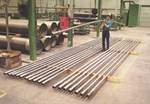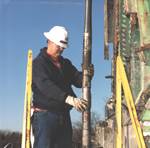Composite Production Riser Projects
ABB Vetco Gray is currently developing a 10.05 inch (ID), all-carbon fiber, top-tensioned production riser, designed for use on TLPs and spars. The design enables operation at an internal pressure of 6,000 psi and a mean bulk temperature of 175°F. Ten prototypes are currently undergoing static and fatigue test
ABB Vetco Gray is currently developing a 10.05 inch (ID), all-carbon fiber, top-tensioned production riser, designed for use on TLPs and spars. The design enables operation at an internal pressure of 6,000 psi and a mean bulk temperature of 175°F. Ten prototypes are currently undergoing static and fatigue tests, employing full acoustic emissions monitoring. Future plans include fabrication of five, full-scale production risers. These will be subjected to static and cyclical loading before they are fatigue-tested to failure.
As part of a NIST Joint Industry Project (JIP), Lincoln Composites designed, developed, manufactured, tested and qualified a composite production riser system for use on a TLP (a different program from the drilling riser, in which JIP Lincoln also participated). In the JIP’s first phase, a low-cost, lightweight riser was designed to operate in water depths of 3,000 to 5,000 ft. The company then fabricated 90 pre-production prototype specimens for testing (10 inch ID single/dual casing joints, for dual completion wells). The prototypes were built in three different lengths (three 7 inch subscale joints, 12 test joints, and 75 pre-production prototype joints). Two full-scale joints were also produced. According to Lincoln, the pre-production riser design that was tested meets critical weight, performance, and cost criteria.
In the critical area of liner design, Conoco and Kværner are testing two different approaches: a riser with an elastomeric liner and another lined with titanium. Both designs feature a steel end connector. After extensive materials testing, the group has fabricated two full-sized joints with fiberoptic sensors embedded in the composite material, which were used to evaluate the riser performance. One of the joints was burst tested by Oil States in Aberdeen, Scotland. The second full-sized, fiberoptic-equipped joint was subjected to a combination of fatigue and static loads at Det Norske Veritas to evaluate the reliability of fiber optics, displacement gauges and acoustic emission monitoring for detecting progressive damage in composite risers.
The overall goal of this project, according to Conoco, is to have an entire composite production riser in place in the field, rather than just a test joint. Conoco has initiated discussions with the U.S. Department of the Interior Minerals Management Service (MMS) to secure their approval.
Related Content
-
Composites manufacturing for general aviation aircraft
General aviation, certified and experimental, has increasingly embraced composites over the decades, a path further driven by leveraged innovation in materials and processes and the evolving AAM market.
-
Cryo-compressed hydrogen, the best solution for storage and refueling stations?
Cryomotive’s CRYOGAS solution claims the highest storage density, lowest refueling cost and widest operating range without H2 losses while using one-fifth the carbon fiber required in compressed gas tanks.
-
Plant tour: Teijin Carbon America Inc., Greenwood, S.C., U.S.
In 2018, Teijin broke ground on a facility that is reportedly the largest capacity carbon fiber line currently in existence. The line has been fully functional for nearly two years and has plenty of room for expansion.









.jpg;maxWidth=300;quality=90)

